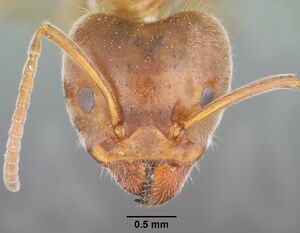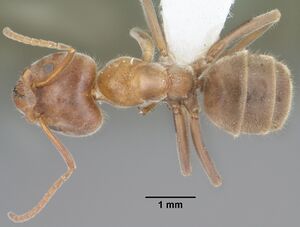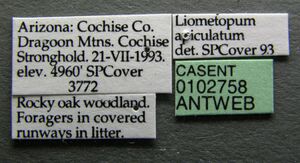Liometopum apiculatum
| Liometopum apiculatum | |
|---|---|

| |
| Scientific classification | |
| Kingdom: | Animalia |
| Phylum: | Arthropoda |
| Class: | Insecta |
| Order: | Hymenoptera |
| Family: | Formicidae |
| Subfamily: | Dolichoderinae |
| Genus: | Liometopum |
| Species: | L. apiculatum |
| Binomial name | |
| Liometopum apiculatum Mayr, 1870 | |
| Synonyms | |
| |
Liometopum apiculatum are common in the Utah Juniper and Pinyon Pine woodlands on Black Mesa. Workers can be identified by the long erect hairs on the pronotum. If disturbed in the field, these ants will emit a strong noxious odor. Workers are polymorphic with the largest individuals approaching the size of small Formica workers.
Photo Gallery
Identification
Polymorphic workers. Light yellow-brown to dark brown with an abundance of short erect to appressed hairs. The body is covered with a dense pubescence, a feature that partially explains the common name for ants in this genus - "velvety tree ants." Liometopum apiculatum can be separated from the co-occurring congener Liometopum luctuosum by a number of features: the workers are lighter relative to the darker colored luctuosum, the hairs on the top of the pronotum are longer and more abundant, and the largest workers in a colony are noticeably larger than the largest luctuosum workers.
Keys including this Species
Distribution
United States, Mexico. Southwestern United States and from northwestern to southeastern Mexico.
Latitudinal Distribution Pattern
Latitudinal Range: 40.22° to 17.75°.
| North Temperate |
North Subtropical |
Tropical | South Subtropical |
South Temperate |
- Source: AntMaps
Distribution based on Regional Taxon Lists
Nearctic Region: United States.
Neotropical Region: Mexico (type locality).
Distribution based on AntMaps
Distribution based on AntWeb specimens
Check data from AntWeb
Countries Occupied
| Number of countries occupied by this species based on AntWiki Regional Taxon Lists. In general, fewer countries occupied indicates a narrower range, while more countries indicates a more widespread species. |

|
Habitat
Occurs sporadically in creosotebush scrub and grasslands, up to sagebrush zones and becomes much more common at higher elevations (1900m) in oak forests (most common habitat), pinyon pine, up to ponderosa pine and riparian sites. (Mackay and Mackay 2002)
Biology
Liometopum apiculatum exist in populous colonies. They can form long and very busy trails that are used for foraging or to connect segments of their polydomous nest. Established trail routes can persist for many years (Shapley 1920). Foraging columns can also be located under the ground and litter, surfacing underneath ground level objects such as rocks and downed wood.
Additional Notes Large colonies of up to 85,000 individuals and aggressive workers help make Liometopum apiculatum a dominant species in its favored habitats. They are abundant in various oak habitat associations that occur from 1000 - 2500 m and in some high elevation (~2000 - 2500 m) pinyon pine, ponderosa pine and riparian areas. Foragers are opportunistic (omnivorous) and will prey upon other organisms. Workers are highly excitable and when a colony or nest fragment is disturbed they burst forth, emitting a noxious alarm pheromone, and quickly swarm upon any unwitting myrmecologists found near the nest. Colonies are rarely investigated because both finding and excavating a nest can be difficult. Foraging trails often disappear into inaccessible holes (e.g. around the roots at the base of a tree) or into a cavity that is more a satellite location where some workers congregate rather than a part of the nest. Workers disappearing under a rock that can be flipped over, for example, are typically found to be using the covering object to make their way into one of their underground trails. In some cases these cavities will contain numerous workers, but no brood, and digging reveals there are no additional nest chambers nearby. When the main section of the nest is found, or suspected to be located, it may be situated in a tree bole or under a large rock.
Liometopum apiculatum queens are among the largest North America ants. Their large size is likely an adaptation for claustral nest founding in what can be a harsh environment for most insects. Associations with other species Workers are known to tend membracids and aphids. They will also visits extrafloral nectaries of some Agave, Yucca and Opuntia plants. In the case of Opuntia imbricata, Liometopum apiculatum provides protective services to the plant. Workers have been shown to be effective at reducing herbivore damage to these plants. Workers will follow the trails of other ant species. In concert with this behavior, workers have been observed successfully soliciting food from of Pogonomyrmex barbatus, Camponotus sayi and Solenopsis xyloni foragers.
Associates found living in the nests of Liometopum apiculatum include a weevil, Liometophilus, a cricket species and a variety of beetle species. A few of the latter are putatively obligate as they are only known from their nest association with this ant.
Foraging
Rafael-Valdez et al. (2017) - A study of 31 colonies in the southern Chihuahuan desert (Mexico) found colonies maintained from 1 to 6 (average = 3.7) active foraging trails that led to a plant or patch of vegetation, with an average travel distance of 38.6 m. Favored plants for foraging workers were Yucca (palm tree), Agave salmiana (agave) and Opuntia rastrera (prickly pear). Longer distances and hence greater foraging effort were observed for Yucca plants. This suggested the palms, with their infestations of scale insects, provided a rich source of honeydew. Harvesting of larvae for sale as escamoles appears to be reducing the abundance of this ant in the study area. (also see Lara-Juárez et al. 2018)
- Unusual and Noteworthy
Liometopum apiculatum brood are a Mexican delicacy known as "escamoles." This food was once used as tribute presented to Aztec Emperors. Today the market demand for brood can be so high that local ant populations of this species are reduced by over-collecting. A typical meal that serves up escamoles is 2 tacos with ~ 50 grams of ants. "They are served fried or with black butter, but the best way is fried with onions and garlic."
Regional Notes
New Mexico
Mackay and Mackay (2002) - This species nests under stones and in trunks of living and dead trees (especially oaks) and dead Yucca spp. stalks. It is polydomous with segments of nests scattered over the landscape under stones and logs. It is the dominant ant in most of the oak forests in the state and can be easily found foraging on the sides of oak trees. This species is predaceous, collects dead insects and tends Homoptera. It is extremely pugnacious and attacks without hesitation. Although it does not sting, it can be very irritating due to bites by large numbers of individuals. Sexuals occur in nests from May to August. Males and females were collected on the ground in June to August, foundress females were commonly collected in July and August under stones, cow manure or logs. They can be found from March to September, one was collected in December. This species nests together with Paratrechina austroccidua, Lasius sitiens (several nests), Lasius pallitarsis, Tapinoma sessile, Forelius and Camponotus vicinus. Inquilines appear to be especially common in the nests of this species. The small cricket, Myrmecophila spp., commonly occurs in the nests throughout its range. Staphylinids including Apteronina schmitti Wasmann and Dinardilla liometopi Wasmann are also found in nests.
Castes
Worker
   
| |
| Worker. . | Owned by Museum of Comparative Zoology. |
Images from AntWeb
   
| |
| Worker. Specimen code casent0102758. Photographer April Nobile, uploaded by California Academy of Sciences. | Owned by CAS, San Francisco, CA, USA. |
Queen
   
| |
| Queen. . | Owned by Museum of Comparative Zoology. |
Images from AntWeb
   
| |
| Queen (alate/dealate). Specimen code casent0004189. Photographer April Nobile, uploaded by California Academy of Sciences. | Owned by CAS, San Francisco, CA, USA. |
Nomenclature
The following information is derived from Barry Bolton's Online Catalogue of the Ants of the World.
- masonium. Formica masonia Buckley, 1866: 165 (w.) U.S.A.
- Combination possibly in Liometopum: Wheeler, W.M. 1902f: 23.
- Incertae sedis in Dolichoderinae: Shattuck, 1994: 171.
- Incertae sedis in Liometopum: Bolton, 1995b: 247.
- Nomen oblitum, synonym of apiculatum: Del Toro, et al. 2009: 316.
- apiculatum. Liometopum apiculatum Mayr, 1870b: 961 (w.) MEXICO.
- Emery, 1895c: 331 (q.); Wheeler, W.M. 1905e: 324 (m.); Wheeler, G.C. & Wheeler, J. 1951: 181 (l.).
- Senior synonym of masonium: Del Toro, et al. 2009: 316.
- Senior synonym of escamole: Boudinot et al., 2022: 135.
- See also: Shattuck, 1994: 128.
- escamole. Lasius escamole Reza, 1925: 12, figs. 1-14 (w.q.m.) MEXICO.
- Unidentifiable to genus; incertae sedis in Lasius: Wilson, 1955a: 192 (who comments that this is not a Lasius but its correct generic combination cannot be ascertained).
- Junior synonym of apiculatum: Boudinot et al., 2022: 135.
Description
References
- Alatorre-Bracamontes, C.E., Vásquez-Bolaños, M. 2010. Lista comentada de las hormigas (Hymenoptera: Formicidae) del norte de México. Dugesiana 17(1): 9-36.
- Boudinot, B.E., Borowiec, M.L., Prebus, M.M. 2022. Phylogeny, evolution, and classification of the ant genus Lasius, the tribe Lasiini and the subfamily Formicinae (Hymenoptera: Formicidae). Systematic Entomology 47, 113-151 (doi:10.1111/syen.12522).
- Del Toro, I., Robbons, R.R., Pelini, S.L. 2012. The little things that run the world revisited: a review of ant-mediated ecosystem services and disservices (Hymenoptera: Formicidae). Myrmecological News 17: 133-146.
- Emery, C. 1895d. Beiträge zur Kenntniss der nordamerikanischen Ameisenfauna. (Schluss). Zool. Jahrb. Abt. Syst. Geogr. Biol. Tiere 8: 257-360 (page 331, queen described)
- Gregg, R.E. 1963. The nest of Liometopum apiculatum Mayr Hymenoptera: Formicidae. University of Colorado Studies, Series in Biology 11: 1-6 (Paper 25).
- Hipolito-Cruz, G., Reyes-López, J., Cadena-Iñiguez, J., Morales-Flores, F.J. 2020. Variabilidad genetica de Liometopum apiculatum Mayr (Hymenoptera: Formicidae) como una medida de conservación en México. AgroProductividad 13. (doi:10.32854/agrop.vi.1724).
- Hoey-Chamberlain, R., Rust, M.K. 2014. Food and bait preferences of Liometopum occidentale (Hymenoptera: Formicidae). Journal of Entomological Science 49(1): 30-43.
- Hoey-Chamberlain, R., Rust, M.K., Klotz, J.H. 2013. A review of the biology, ecology and behavior of Velvety Tree Ants of North America. Sociobiology 60(1): 1-10.
- Hoey-Chamberlain, R.V. 2012. Food preference, survivorship, and intraspecific interactions of Velvety Tree Ants. M.S. thesis, University of California, Riverside.
- LaPolla, J.S. 2023. Fossil ants (Hymenoptera: Formicidae) of the early Oligocene Canyon Ferry Reservoir deposit. Palaeoentomology 6(4), 385-397 (doi:10.11646/palaeoentomology.6.4.10).
- Lara-Juarez, P., J. R. A. Rivera, P. C. Lara, and J. A. Reyes-Aguero. 2018. Collecting pupae (Escamoles) of Liometopum apiculatum (HYMENOPTERA, FORMICIDAE, DOLICHODERINAE) In the San Luis Potosi high plain, Mexico. Interciencia. 43:763-769.
- Mackay, W. P. and E. Mackay. 2002. The ants of New Mexico (Hymenoptera: Formicidae). Edwin Mellen Press, Lewiston, NY.
- Mayr, G. 1870b. Neue Formiciden. Verh. K-K. Zool.-Bot. Ges. Wien 20: 939-996 (page 961, worker described)
- Mendoza-Guido, B., Rodríguez-Hernández, N., Ivens, A.B.F., von Beeren, C., Murillo-Cruz, C., Zuniga-Chaves, I., Łukasik, P., Sanchez, E., Kronauer, D.J.C., Pinto-Tomás, A.A. 2023. Low diversity and host specificity in the gut microbiome community of Eciton army ants (Hymenoptera: Formicidae: Dorylinae) in a Costa Rican rainforest. Myrmecological News 33: 19-34 (doi:10.25849/MYRMECOL.NEWS_033:019).
- Rafael-Valdez, J., L. A. Tarango-Arambula, S. Ugalde-Lezama, E. A. Lozano-Cavazos, V. M. Ruiz-Vera, and A. Bravo-Vinaja. 2017. Foraging and nesting substrates of the Escamolera ant (Liometopum apiculatum Mayr, Himenoptera: Formicidae) in Villa Gonzalez Ortega, Zacatecas, Mexico. Agrociencia. 51:755-769.
- Shattuck, S. O. 1994. Taxonomic catalog of the ant subfamilies Aneuretinae and Dolichoderinae (Hymenoptera: Formicidae). Univ. Calif. Publ. Entomol. 112:i-xix, 1-241. (page 128, see also)
- Wheeler, G. C.; Wheeler, J. 1951. The ant larvae of the subfamily Dolichoderinae. Proc. Entomol. Soc. Wash. 53: 169-210 (page 181, larva described)
- Wheeler, W. M. 1905h. The North American ants of the genus Liometopum. Bull. Am. Mus. Nat. Hist. 21: 321-333 (page 324, male described)
References based on Global Ant Biodiversity Informatics
- Alatorre-Bracamontes, C.E. and M Vasquez-Bolanos. 2010. Lista comentada de las hormigas (Hymenoptera: Formicidae) del norte de México. Dugesiana 17(1):9-36
- Andersen A. N. 1997. Functional Groups and Patterns of Organization in North American Ant Communities: A Comparison with Australia. Journal of Biogeography. 24: 433-460
- Browne J. T., R. E. Gregg. 1969. A study of the ecological distribution of ants in Gregory Canyon, Boulder, Colorado. University of Colorado Studies. Series in Biology 30: 1-48
- Cokendolpher J. C., and O. F. Francke. 1990. The ants (Hymenoptera, Formicidae) of western Texas. Part II. Subfamilies Ecitoninae, Ponerinae, Pseudomyrmecinae, Dolichoderinae, and Formicinae. Special Publications, the Museum. Texas Tech University 30:1-76.
- Cokendolpher J.C., Reddell J.R., Taylor S.J, Krejca J.K., Suarez A.V. and Pekins C.E. 2009. Further ants (Hymenoptera: Formicidae) from caves of Texas [Hormigas (Hymenoptera: Formicdae) adicionales de cuevas de Texas]. Texas Memorial Museum Speleological Monographs, 7. Studies on the cave and endogean fauna of North America, V. Pp. 151-168
- Cover S. P., and R. A. Johnson. 20011. Checklist of Arizona Ants. Downloaded on January 7th at http://www.asu.edu/clas/sirgtools/AZants-2011%20updatev2.pdf
- Cruz-Labana, J. D., L. A. Tarango-Arambula, J. L. Alcantara-Carbajal, J. Pimentel-Lopez, S. Ugalde-Lezama, G. Ramirez-Valverde, and S. J. Mendez-Gallegos. 2014. Uso de habitat por la hormiga escamolera (Liometopum apiculatum Mayr) en el centro de Mexico. Agrociencia 48: 569-582.
- Dattilo W. et al. 2019. MEXICO ANTS: incidence and abundance along the Nearctic-Neotropical interface. Ecology https://doi.org/10.1002/ecy.2944
- Del Toro I., J. A. Pacheco, W. P. MacKay. 2009. Revision of the ant genus Liometopum (Hymenoptera: Formicidae). Sociobiology 53: 299-369.
- Eastlake Chew A. and Chew R. M. 1980. Body size as a determinant of small-scale distributions of ants in evergreen woodland southeastern Arizona. Insectes Sociaux 27: 189-202
- Fernandes, P.R. XXXX. Los hormigas del suelo en Mexico: Diversidad, distribucion e importancia (Hymenoptera: Formicidae).
- Gregg, R.T. 1963. The Ants of Colorado.
- Hernandez-Roldan, E., L. A.Tarango-Arambula, S. Ugalde-Lezama, A. Hernandez-Juarez, C. Cortez-Romero, Y. Cruz-Miranda, and F. J. Morales-Flores. 2017. Habitat y densidad de nidos de la hormiga escamolera (Liometopum apiculatum Mayr) en una UMA de Zacatecas, Mexico. Agroproductividad 10: 10-17.
- Hernandez-Ruiz P., G. Castano-Meneses, and Z. Cano-Santana. 2009. Composition and functional groups of epiedaphic ants (Hymenoptera: Formicidae) in irrigated agroecosystem and in nonagricultural areas. Pesq. agropec. bras., Brasília, 44(8): 904-910.
- Higgins R. J., and B. S. Lindgren. 2010. Ants of British Columbia (Hymenoptera: Formicidae). 1-6.
- Johnson R. Personnal Database. Accessed on February 5th 2014 at http://www.asu.edu/clas/sirgtools/resources.htm
- Lachaud J. P., and G. Perez-Lachaud. 2013. Revisión preliminar de las hormigas de Campeche y Quintana Roo, México, con base en la colección de Arthropoda del Colegio de la Frontera Sur. In Formicidae de Mexico (eds. M. Vasquez-Bolanos, G. Castano-Meneses, A. Cisneros-Caballero, G. A. Quiroz-Rocha, and J. L. Navarrete-Heredia) p21-32.
- Lara-Juarez, P., P. Castillo-Lara, F. D. M. Tristan-Patino, J. A. Rendon-Huerta, and J. R. Aguirre-Rivera. 2016. Range site and condition effects on escamoles ant (Liometopum apiculatum Mayr) nest density. Revista Chapingo. Serie Ciencias Forestales y del Ambiente 22: 285-302.
- Longino, J.T. 2010. Personal Communication. Longino Collection Database
- MacGown J. A., T. L. Schiefer, and M. G. Branstetter. 2015. First record of the genus Leptanilloides (Hymenoptera: Formicidae: Dorylinae) from the United States. Zootaxa 4006 (2): 392–400.
- MacKay W. P. 1993. Succession of ant species (Hymenoptera: Formicidae) on low-level nuclear waste sites in northern New Mexico. Sociobiology 23: 1-11.
- Mackay W. P., and E. E. Mackay. 2002. The ants of New Mexico (Hymenoptera: Formicidae). Lewiston, New York: Edwin Mellen Press, 400 pp.
- Mackay, W., D. Lowrie, A. Fisher, E. Mackay, F. Barnes and D. Lowrie. 1988. The ants of Los Alamos County, New Mexico (Hymenoptera: Formicidae). pages 79-131 in J.C. Trager, editor, Advances in Myrmecololgy.
- Navarrete-Heredia J. L., M. Vasquez-Bolano, and G. A. Quiroz-Rocha. 2007. New mexican distributional data on the Sceptobiini-Liometopum association (Coleoptera: Staphylinidae, Aleocharinae-Hymenoptera: Formicidae, Dolichoderinae). Sociobiology 49(3): 221-229.
- O'Keefe S. T., J. L. Cook, T. Dudek, D. F. Wunneburger, M. D. Guzman, R. N. Coulson, and S. B. Vinson. 2000. The Distribution of Texas Ants. The Southwestern Entomologist 22: 1-92.
- Ramos-Elorduy, J., E.M. Costa Neto, J.M. Pino, M. del S. Cuevas Correa, J. Garcia-Figueroa and D.H. Zerina. 2007. Conocimiento de la entomofauna útil en el poblado La Purísima Palmar de Bravo, Estado de Puebla, México. Biotemas 20(2):121-134
- Reddell J. R., and J. C. Cokendolpher. 2001. Ants (Hymenoptera: Formicidae) from caves of Belize, Mexico, and California and Texas (U.S.A.) Texas. Texas Memorial Museum Speleological Monographs 5: 129-154.
- Van Pelt, A. 1983. Ants of the Chisos Mountains, Texas (Hymenoptera: Formicidae) . Southwestern Naturalist 28:137-142.
- Varela-Hernandez, F., M. Rocha-Ortega, R. W. Jones, and W. P. Mackay. 2016. Insectos: Hormigas (Formicidae) del estado de Queretaro, Mexico. Pages 397-404 in W. Jones., and V. Serrano-Cardenas, editors. Historia Natural de Queretaro. Universidad Autonoma de Queretaro, Mexico.
- Varela-Hernandez, F., M. Rocha-Ortega, W. P. Mackay, and R. W. Jones. 2016. Lista preliminar de las hormigas (Hymenoptera: Formicidae) del estado de Queretaro, Mexico. Pages 429-435 in . W. Jones., and V. Serrano-Cardenas, editors. Historia Natural de Queretaro. Universidad Autonoma de Queretaro, Mexico.
- Vasquez Bolanos M., and J. Escoto Rocha. 2018. Ants (Hymenoptera: Formicidae) of Aguascalientes. Investigacion y Ciencia 24(68): 36-40.
- Vasquez-Bolanos M. 2011. Checklist of the ants (Hymenoptera: Formicidae) from Mexico. Dugesiana 18(1): 95-133.
- Velasco Corona C., M. del Carmen Corona-Vargas, and R. Pena-Martinez. 2007. Liometopum apiculatum (Formicidae: Dolichoderinae) y su relacion trofobiotica con hemiptera Sternorrhyncha en Tlaxco, Tlaxcaala, Mexico. Acta Zoologica Mexicana 23(2): 31-42.
- Vásquez-Bolaños M. 2011. Lista de especies de hormigas (Hymenoptera: Formicidae) para México. Dugesiana 18: 95-133
- Wheeler W. M. 1905. The North American ants of the genus Liometopum. Bulletin of the American Museum of Natural History 21: 321-333.
- Wheeler W. M. 1914. Ants collected by W. M. Mann in the state of Hidalgo, Mexico. Journal of the New York Entomological Society 22: 37-61.
- Wheeler W. M. 1917. Notes on the marriage flights of some Sonoran ants. Psyche (Cambridge) 24: 177-180.
- Wheeler W. M. 1917. The mountain ants of western North America. Proceedings of the American Academy of Arts and Sciences 52: 457-569.
- Wheeler, G.C. and J. Wheeler. 1985. A checklist of Texas ants. Prairie Naturalist 17:49-64.



